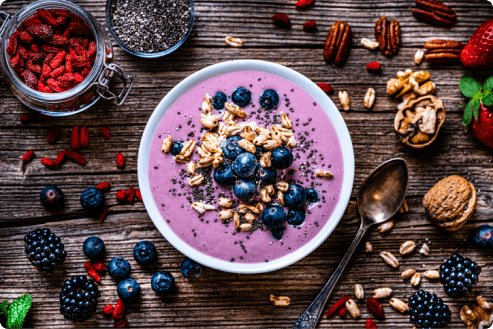Nutrition Before, During and After Treatment
Eating the right foods and maintaining proper nutrition before, during and after mesothelioma treatment promotes healing and improves your quality of life.

Eating the Right Foods Before Treatment
Many people have lost weight because of cancer before they receive a mesothelioma diagnosis. Mesothelioma patients have specific nutritional needs at each part of their cancer journey.
Losing weight without trying can lead the body to consume muscle, organs, blood and immune cells for energy. Unplanned weight loss can be harmful.
To prepare your body for the challenges before mesothelioma treatment, focus on:
- Healthy Calories: Avocados, peanut butter, other nuts and nut butters, olive oil, dried fruit, potatoes and sweet potatoes, squash, whole grains (e.g., brown rice, oatmeal and quinoa), oily fish (e.g., salmon, sardines and anchovies) and fruit smoothies.
- Healthy Protein: Lean meats, chicken, turkey, fish, beans, peas, lentils, chickpeas, Greek yogurt, nuts, seeds, milk, whey protein powder-based smoothies and whole eggs.
- Vegetables and Fruit: Spinach, kale, other green leafy vegetables, broccoli, cauliflower, bell peppers, carrots, blueberries, blackberries, cherries, apples, oranges, bananas and any other colorful whole food you enjoy.
Balance your plate before treatment. Cover half with healthy protein foods. Cover the other half with a combination of healthy, high-calorie options and fruits and vegetables.
Access top doctors, and get help scheduling appointments.
Connect NowDr. Jacques Fontaine, Pleural Mesothelioma Specialist

Nutrition During Treatment
Mesothelioma and its treatment may cause a variety of dietary side effects. Proper nutrition is a critical component of mesothelioma treatment. The right nutrients provide fuel for healing, maintaining immunity and rebuilding the body.
A 2022 study showed the importance of mesothelioma patients to maintain skeletal muscle mass. Those who maintained muscle mass had a greater chance of survival after 12 months. This was compared to patients with increased sedentary time and lower rates of light activity.
Calories are more important than type of food at this time. Be flexible and add other foods as needed to keep calories coming into your body.
Tips to make the most of every bite and sip:
- Add cheese and cooked meats to omelets, sandwiches, soups, salads and casseroles.
- Blend one packet of dry milk powder into one quart of whole milk to increase protein.
- Drink high-calorie liquids such as whole fat milk, 100% fruit juice and milk smoothies with added whey protein powder.
- Blend nut butters or ice cream into smoothies and milkshakes.
- Try a plant-based milk with protein powder added if you’re having trouble tolerating dairy.
- Snack on nut butters or roasted nuts.
- Enjoy egg-based desserts such as cheesecake, custard and pudding.
Giving yourself permission to eat the foods you really like can be helpful when your appetite is unsteady, but some foods can cause other issues. Spicy foods, greasy or fried foods, for example, may cause discomfort or even damage your stomach.
Be ready to break your normal routines. It may be easier to manage multiple small meals and snacks than three large meals. Try a few bites at a time every 60 to 90 minutes.
If meal times were your time to catch up on the day with family, create a new time for this. Adapting to your new realities around food and meals will reduce stress and expectations for you to eat more than you can at any one time.
Maintaining Proper Nutrition After Treatment
Once your mesothelioma symptoms and side effects have diminished, it’s time to fuel your recovery. Eating at this phase reflects the same goals prior to treatment but with a few tweaks.
Focus on plenty of healthy protein sources such as chicken, turkey, fish, eggs and beans. Now you can shift to covering about 1/3 of your plate with these foods instead of 1/2. Cover the other 2/3 of your plate with green leafy vegetables and other colorful vegetables and fruit.
The final bit of plate space should include healthy fats, oils and high-calorie foods. These consist of avocados, nuts, starchy vegetables such as sweet potatoes and squash, whole grains and olive oil.
Don’t underestimate the power of an appealing presentation. Patients often feel more enticed to eat their meals when they are well-presented. Colorful dishes and colorful fresh fruits and vegetables as a garnish can help. Unique placemats or your favorite music at mealtime can help as well.
Recommended Reading


